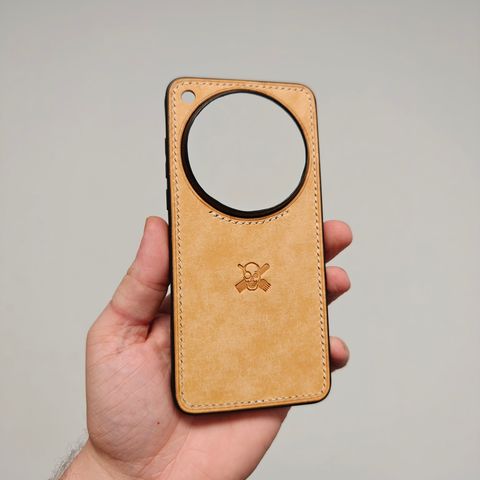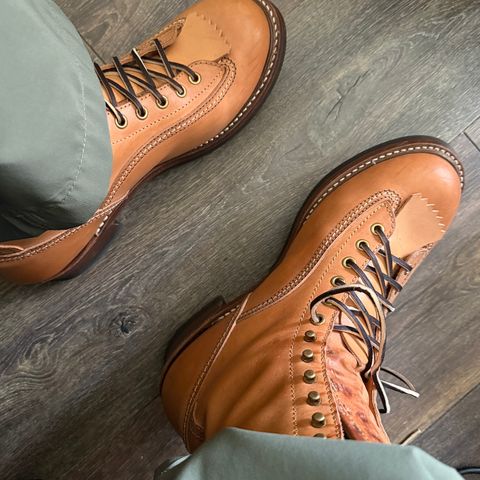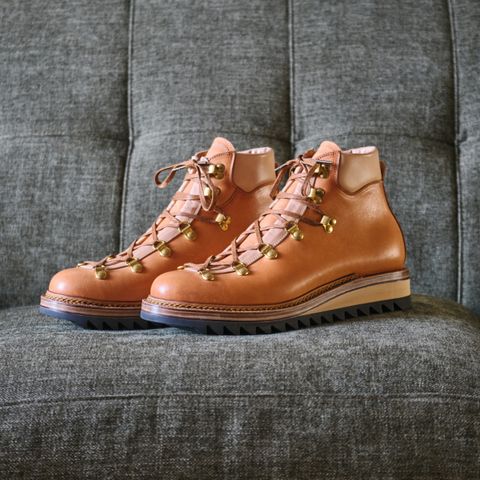About
Badalassi Carlo Bone Pueblo is a color variation of Pueblo leather produced by Badalassi Carlo in San Miniato, Tuscany. The leather features a natural, off-white bone coloration achieved through transparent aniline dyeing applied to vegetable-tanned cowhide. Bone Pueblo combines the technical properties of Pueblo leather—including full-grain vegetable tanning, matte stone-ground surface, and rapid patina development—with a light neutral color that darkens significantly through wear and aging.
About
Badalassi Carlo Bone Pueblo is a color variation of Pueblo leather produced by Badalassi Carlo in San Miniato, Tuscany. The leather features a natural, off-white bone coloration achieved through transparent aniline dyeing applied to vegetable-tanned cowhide. Bone Pueblo combines the technical properties of Pueblo leather—including full-grain vegetable tanning, matte stone-ground surface, and rapid patina development—with a light neutral color that darkens significantly through wear and aging.
The Bone variation represents one of the lighter colorways in the Pueblo range, allowing for dramatic visual transformation as the leather develops patina. The off-white base color shows natural marks, use patterns, and environmental effects more readily than darker variations, creating distinctive character evolution that appeals to users who value visible material aging. The transparent aniline dyeing process allows the natural grain and texture of the leather to remain fully visible while providing the subtle bone coloration.
Color characteristics
Bone Pueblo displays off-white to pale cream tones that fall within the natural bone color spectrum. The coloration results from transparent aniline dyes applied during Badalassi Carlo's traditional vegetable tanning process, where natural tannins extracted from tree bark are combined with fatliquoring using animal fats inside wooden barrels. The transparent dyeing allows the dye to penetrate completely through the material from grain to flesh side rather than remaining only on the surface.
The vegetable tanning foundation contributes to the color's natural appearance, as the tannins interact with the collagen structure of the hide to create depth beyond simple surface application. This depth becomes more apparent through wear, with flexed and creased areas showing tonal variation as the leather's pull-up characteristics and patina development reveal darker undertones. The full-grain leather maintains visibility of natural marks present in the cowhide, appearing as variations in surface texture and color absorption.
Natural marks present in the steerhide remain highly visible in Bone Pueblo due to the light base color. These variations—including scratches, wrinkles, and grain patterns—integrate into the overall appearance and become more pronounced as the leather ages. The stone-ground surface treatment creates a matte, slightly textured finish that interacts with the bone color to produce the characteristic appearance. Color consistency within production batches follows natural variation typical of vegetable-tanned leather, with acceptable tonal differences between hides reflecting the organic nature of the material and tanning process.
Physical properties
Bone Pueblo retains all physical characteristics of the Pueblo leather type, including full-grain vegetable-tanned base structure, hand-buffed stone-ground surface, and transparent aniline finish. The leather exhibits a matte surface with suede-like texture resulting from the stone-polishing and hand-buffing process where iron balls are rolled over the surface. The finish provides natural breathability characteristic of vegetable-tanned leather while the fatliquoring process adds oils and waxes that support aging and patina development.
The leather shows pull-up effects where bent or stretched, with the bone color lightening in flexed areas to reveal the vegetable-tanned base beneath. This pull-up behavior proves more visible in lighter colors like Bone compared to darker Pueblo variations, adding visual interest during wear. The matte finish remains consistent with other Pueblo colors, providing a stone-ground appearance without high gloss or excessive sheen.
Weight specifications for Bone Pueblo match standard Pueblo production at 5 ounces (2mm plus or minus 0.2mm), with medium temper suitable for both structured applications requiring shape retention and flexible items requiring comfort. The vegetable-tanned base provides natural characteristics including ready absorption of oils and conditioners, though the leather already contains oils from the fatliquoring process. The full-grain surface retains natural grain patterns and marks, contributing to the material's authentic character and aging potential.
Applications
Bone Pueblo finds application in heritage footwear where light-colored leather with dramatic patina potential aligns with aesthetic goals. The leather's combination of medium temper and rapid aging characteristics suits boots and shoes where visible material evolution forms part of the desired appearance. The 5-ounce weight provides sufficient structure for boot uppers while maintaining flexibility necessary for comfortable break-in and extended wear.
The light bone color shows scuffs, scratches, and wear patterns readily, making it particularly suitable for users who value visible aging and authentic wear character. The material's patina development accelerates compared to darker colors due to the light base showing contrast more dramatically as oils, dirt, and handling darken high-contact areas. This characteristic appeals to heritage footwear enthusiasts and leather goods makers who prioritize natural material evolution.
Beyond footwear, Bone Pueblo's characteristics suit leather goods applications including watch straps, wallets, and small accessories where light-colored leather with aging potential proves desirable. The vegetable-tanned structure accepts burnishing for edge finishing, allowing clean edges without additional treatments. The matte stone-ground surface provides tactile interest and visual texture, while the suede-like finish offers different hand feel compared to smooth vegetable-tanned leathers.
The material works well for both exterior and interior applications, with the stone-ground grain face suited for visible surfaces and the smooth flesh side appropriate for linings. The light color creates visual contrast when paired with darker leathers or hardware, while the natural aging process ensures the material develops unique character reflecting individual use patterns.
Aging and patina development
Bone Pueblo develops patina rapidly compared to other vegetable-tanned leathers and more dramatically than darker Pueblo variations. The light base color shows wear effects, oil absorption, and handling marks readily, creating visible transformation within weeks of regular use. High-flex areas including vamp creases, ankle bends, and handling points darken first as the leather absorbs oils from skin contact and environmental exposure.
The leather ages through natural oxidation, mechanical wear, and oil absorption rather than requiring heavy conditioning. Flexing and creasing during wear compress leather fibers and bring internal oils to the surface, revealing color changes and creating the distinctive patina associated with vegetable-tanned leather. The transparent aniline dyeing allows patina to develop throughout the leather thickness rather than remaining superficial, contributing to depth of color evolution.
Environmental factors including sunlight exposure, moisture contact, and air quality contribute to aging effects. UV exposure may cause some lightening or yellowing in certain areas, while protected sections maintain the original bone tone, creating natural variation. Moisture exposure typically darkens the leather temporarily, with repeated wetting cycles contributing to overall color deepening over time. The vegetable tanning foundation supports these aging processes without deteriorating the material structure.
Natural marks and imperfections present from production become more pronounced through aging. Small scratches, grain variations, and texture differences accept oils and dirt differently than surrounding leather, creating individualized character unique to each item. This natural variation contributes to Bone Pueblo's appeal among leather enthusiasts who value authentic material evolution over uniform appearance.
The minimal finishing of Pueblo leather—limited to transparent aniline dyeing and stone-ground surface treatment—allows the leather's inherent characteristics to dictate aging patterns. Regular buffing with a dry cloth accelerates the burnishing process, increasing both the darkness of high-contact areas and the level of shine, transforming the original matte finish to a glossy patina in worn sections while less-handled areas retain more of the original stone-ground texture.
Care and maintenance
Bone Pueblo requires measured conditioning due to the oils present from fatliquoring during manufacturing. The leather retains natural oils and waxes from the wooden barrel processing, reducing the need for frequent product application while supporting natural patina development. Light cleaning with damp cloth removes surface dirt and dust without stripping the leather's natural oils or affecting the stone-ground finish.
For conditioning, natural leather creams and waxes represent appropriate product types, as they nourish vegetable-tanned leather without substantially altering color or interfering with patina evolution. Application should remain light and infrequent, with conditioning necessary only when the leather shows excessive dryness—typically manifesting as loss of suppleness or surface cracking. Heavy oils and mink oil-based conditioners may darken Bone Pueblo significantly and reduce the leather's ability to develop natural wear patterns and color variation.
The light bone color shows dirt, oils, and handling marks readily, which forms part of the leather's intended aging character rather than representing a defect. Attempting to prevent darkening through aggressive cleaning or protective treatments interferes with natural patina development. Users seeking to maintain the original light color should minimize handling and exposure, though this approach contradicts the material's designed purpose of developing character through use.
Water exposure should be minimized, as vegetable-tanned leather absorbs moisture readily. Brief water contact should be addressed by allowing the leather to air dry naturally at room temperature. Forced drying through heat application may affect leather temper and finish characteristics. Water exposure typically creates temporary darkening that may or may not fade completely upon drying, contributing to overall patina patterns over time.
Regular buffing with a dry cloth proves beneficial for Bone Pueblo, as the mechanical action burnishes the surface and accelerates the development of shine in high-contact areas. This simple maintenance creates the characteristic glossy patina associated with aged Pueblo leather while requiring no products or treatments. The goal of maintenance for Bone Pueblo centers on preservation of the leather's structure while allowing natural aging to occur, supporting material evolution rather than preventing it.
References
"Badalassi Carlo Tannery Profile". Genuine Italian Vegetable Tanned Leather Consortium. Retrieved October 30, 2025.
"Badalassi Carlo - Pueblo - Veg Tanned Leather". Rocky Mountain Leather Supply. Retrieved October 30, 2025.
"Pueblo Leather from Badalassi Carlo Tannery". Delugs. Retrieved October 30, 2025.
"Why Badalassi Carlo Pueblo Leather Is The Best Choice For Your Watch Strap". Hand & Needle. Retrieved October 30, 2025.





































































